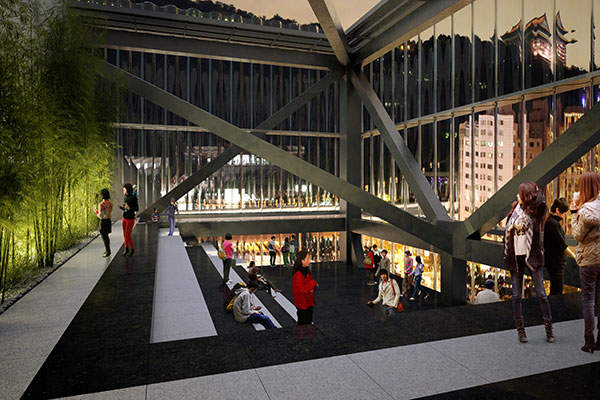The Taipei Performing Arts Centre is a cultural and theatrical complex located in the Shilin District, Taipei, Taiwan.
The project was undertaken by the Department of Cultural Affairs, Taipei City Government, to promote the development of local performing arts groups and to improve Taipei’s image as an international cultural hub.
OMA won the competition to design the Taipei Performing Arts Centre in January 2009, out of 135 entries. Construction of the complex began in February 2012 on a 20,750m² site located next to the Shilin Night Market, and the building topped out in August 2014.
Test performances took place at the centre between March and May 2022. The project was completed in May 2022 while the official opening is scheduled to take place in August later this year.
Built with an estimated budget of TWD5.4bn ($170.5m), the facility will be capable of hosting a wide range of performances including contemporary drama, classical Chinese opera, modern dance, and rock concerts.
Design of the asymmetrical Taipei Performing Arts Centre
The design of the Taipei Performing Arts Centre is inspired by a traditional Chinese woodblock puzzle and comprises three independent auditoriums projecting out of a compact central cube. The building includes a 1,500-seat Grand Theatre, an 800-seat Multiform Theatre, and an 800-seat Proscenium Playhouse.
The transparent central cube houses the foyers, stages, rehearsal rooms, and shared backstage space and mechanical facilities. The main seating areas of the three auditoriums are cantilevered outside the cube and supported above the ground by columns.
The Grand Theatre and Multiform Theatre projects from the south and north face of the cube while the Proscenium Playhouse extends toward the train station and the green mountain.
The spherical Proscenium Playhouse resembles a suspended planet, which is visible from a distance. A unique proscenium has been created at the intersection of the inner shell of the sphere and the cube, inside the auditorium.
The contemporary Grand Theatre has an asymmetrical shape, with an angled floor and a movable ceiling. The folded plane in the interior houses the stage level, parterre, and balcony. The Multiform Theatre was designed as a black box theatre, opposite the Grand Theatre on the same level.
The Grand and Multiform theatres, which are at opposite ends of a horizontal axis, can be combined into a Super Theatre, which has a factory-like environment and a 100m-long space to accommodate experimental theatrical performances.
A public loop mediates through the theatres, backstage areas, and production spaces, allowing the audience and the general public to observe theatre production first-hand. This loop starts at the entry foyer, leading to the roof of the building, which holds an open-air terrace with a bar for small outdoor performances.
Parking and plant rooms are located in the single-story basement.
Structural features
The exterior of the Taipei Performing Arts Centre is made up of glass and aluminium. The central cube is wrapped with corrugated glass while the three theatres are enveloped by large aluminium panels.
The theatres feature double windows and wall constructions to keep out unwanted noise and vibrations.
A base isolation structural system and a friction pendulum isolator system (FPS) are included to support the irregular architectural form of the building.
The base isolation system reduces the seismic forces acting on the building while the FPS has a high bearing pressure that supports the large columns required for the building. The 12-storey high steel structure, with a single-story basement, rises above the isolation layer.
Beam-column and bracing frames around the cube structure comprise the exterior framing systems and provide stability to the building. The three cantilevered auditoriums protruding from the cube are connected by truss systems.
Contractors involved in the Taipei Performing Arts Centre
Artech Architects acted as the local architect for the project, and IEC Group was responsible for building the structure. Arup provided consultation regarding structure, mechanical, electrical, and public health engineering, building physics, and fire engineering.
International Engineering & Construction, a Taiwanese construction firm, was appointed as the general contractor for the project.
Sun-Sea Construction, an engineering and construction company based in Taiwan, was selected for the construction of the facade while Ancang Construction was tasked with the responsibility of interior works and landscaping.
Taipei-based Evergreen Consulting Engineering provided structural engineering services while Taiwan Fire Safety Consulting provided fire engineering services.
Jung Yan Interior Design & Decoration and Tech-Top Engineering were contracted to provide mechanical, electrical, and plumbing (MEP) and fire engineering services for the project.
Shiu Guan Machine Electric Engineering, an electrical goods supplier based in Taiwan, was selected to equip the arts centre with air conditioning systems.
Jardine Schindler Lifts, a vertical transport services provider based in Hong Kong, supplied and installed the elevators at the Taipei Performing Arts Centre.
Heng Kai and IS Leng and Associates Engineers were responsible for services engineering while Sino Geotech was contracted as the geotechnical engineer.
ABT and CDC acted as the facade engineers while Inside Outside offered interior and landscape designing services for the project. Royal HaskoningDHV was the acoustic consultant for the project.
Ducks Scéno, a French firm specialising in scenography and museography, and Creative Solution Integration, a Taiwanese specialised design solutions provider, acted as the theatre consultants during the design phase.
The theatre equipment contract for the project was awarded to L&K Engineering, a Taiwanese construction and engineering firm; IX Technology, a mechanical and electrical critical infrastructure services provider based in Singapore; and JR Clancy, a music and theatre products and solutions provider based in the US.
Traffic consultation service was provided by Everest Engineering Consultants while Segreene Design and Consulting was responsible for sustainability consultation. Chroma 33 was appointed as the lighting consultant for the project.
RJ Models provided architectural modelling services for the project.











